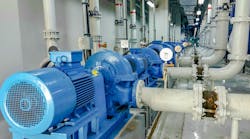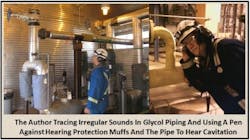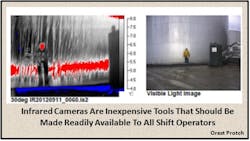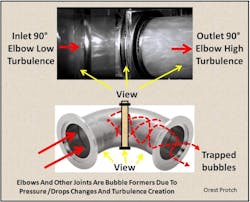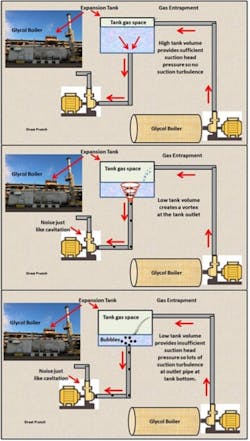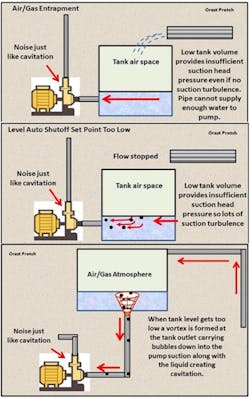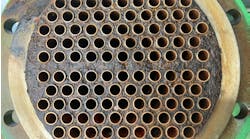A major problem in using this simple sound-listening technique is that process changes can affect the flows through a system, and this, of course, changes the acoustic patterns that you are trying to identify. To reduce ambient noise during the troubleshooting process, engineers may be tempted to ask the control room to slow down the process. Wrong move. When you slow down a process to use a sound-listening technique, the flow through the piping and pump systems changes, making it difficult to identify what’s causing cavitation.
Your ears are an incredible process troubleshooting tool. With this technique, you can hear sounds in pumps and piping even though the process ambient noises can be felt seemingly vibrating through your entire body, from head to toe. It works even if you have double hearing protection; foam plugs and earmuffs, as seen in Figure 1. Learn to listen to the process. It’s always trying to tell you something.
From the Camera’s Eye
Identifying pump cavitation is challenging because most chemical industrial processes have a multitude of online instrumentation, valves, elbows, expansion joints, flanges, density meters, assorted probes and venturi tubes that impact performance. Now, add process liquids and precipitated solids that can cause scaling and corrosion, and a whole new investigation world for possible cavitation sources opens.
As liquids pass through piping, the inner surface acts like a brake causing the fluids closest to the sides to slow down via friction. This means the center flow is faster than the outermost flow, and this causes turbulence. And turbulence causes sine-like pressure waves to go with the flow. The faster the flow, the greater the turbulence and the greater the pressure waves.
When the turbulent flow and pressure waves reach restrictions in the piping, such as elbows, pressure drops cause bubbles to drop out of solution and head toward the pumps. Liquids and slurries tend to drop out solids either as actual solids or to come out as scale, not only on the inner pipe surfaces but also in flanges, elbows and other parts. These also act as flow restrictors, causing turbulence by decreasing fluid velocities where they meet increased flows through a pipe's center. This will also increase sine wave pressure drops.
Infrared cameras (Figure 2) are an inexpensive tool that should be available to all operator shift teams in addition to maintenance personnel. Operators understand the equipment perhaps better than anyone else in the facility since they spend an entire shift working with it.
The cameras will show sediment build-up in doglegs of pipe galleries, where flows change direction, but the solids material in the stream may drop out. The image will also show the accumulation of solids in the bottom of tanks. This is especially important to note when solids shouldn’t be present anywhere in the system, or at least very little of it. Inside process piping, the liquids are under pressure and have a certain temperature, viscosity and density. If something changes in the process parameters, then dissolved solids may come out of solution and precipitate out. This is a red flag for scale formation inside the pipes feeding the tank and for pipe galleries ahead of pumps.
